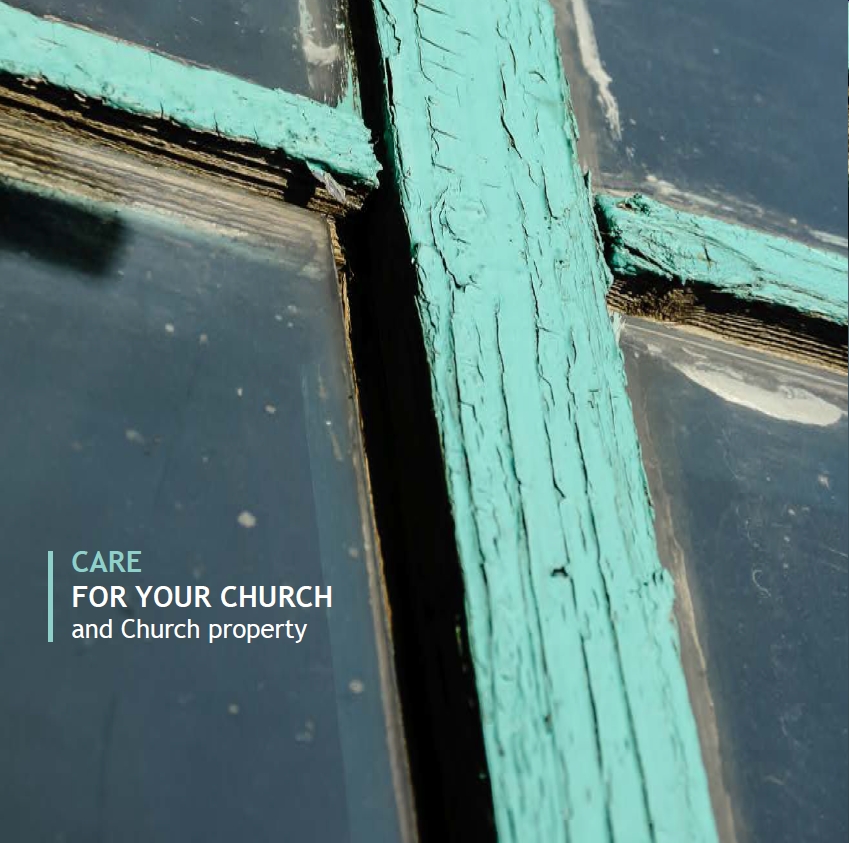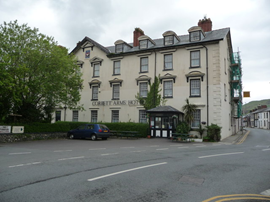Care for your church and church property
Contents |
Introduction
A small regular investment in maintenance can limit the need for, or extent of, expensive repairs: the annual cleaning of gutters and drains can be much cheaper and less inconvenient than having to cope with a serious outbreak of dry rot in timber roof trusses following years of neglect.
Old buildings also contain ‘embodied energy’. All the effort and materials it took to build them in the past will be wasted if they are allowed to rot, which is hardly a sustainable position in the age of sustainability.
Roofs
Even minor leaks can lead to severe problems if left unattended. It is therefore essential that regular maintenance is carried out to ensure the roof remains wind and watertight.
It is recommended that inspections are carried out by a Chartered Professional with conservation accreditation, but regular monitoring by Church volunteers can spot slipped slates or other changes which could require urgent attention.
Repairs should be carried out by a trained and experienced contractor under professional direction.
Original slates should be carefully salvaged and set aside for later reinstatement. Replacement slates should be introduced to less noticeable areas of the roof, with originals being set aside for use in the more prominent areas.
New slates should match the original building material as closely as possible in type, colour, texture, size and thickness.
Only where roofing materials have come to the natural end of their life or repairs are no longer cost effective should the full reslating of a roof be considered.
A rough guide is that where one fifth or more of the slates have to be renewed, re-roofing should be considered.
Check for defects such as:
- slipped or missing slates
- areas of staining
- roof deflection
- missing flashing
- mould and algae growth.
Walls
Walls form the main part of the structural envelope and need appropriate protection and maintenance. Inappropriate repairs to brick and stone can cause serious damage. Always seek advice from a Chartered Professional with conservation accreditation before carrying out any repointing and consult a structural engineer if you have concerns about the stability of a wall.
Brick and stone relies on the integrity and flexibility of the mortar used to keep water out of a building. Missing mortar and cracked and open joints all allow water penetration, which is particularly damaging when frost occurs.
Limestone is soft and easily damaged by inappropriate repairs or harsh cleaning. Any work to stonework should be carried out by a qualified professional.
Render is used to provide a protective and decorative finish to a wall and was traditionally lime based. This allowed the wall behind to breathe as well as being flexible enough to accommodate movement in the building materials.
Modern cement renders are harder and can trap moisture behind, forcing it into the building fabric and are inappropriate for traditional solid walls. Boast sections of render or plaster indicate separation from the wall behind and necessitates them to be repaired.
Similarly internal plasters were traditionally lime based. Inappropriate repair or decoration using non mineral/ lime based products can cause damage.
Check for defects such as:
- mould and algae growth
- signs of plant growth
- signs of cracking
- areas of staining
- damp patches
- erosion.
Gutters and downpipes
Water is the main agent of damage to buildings. Blocked, cracked or badly-designed rainwater goods can allow water into the walls and roof timbers of a church building. The resulting damp encourages timber decay through fungal attack and insect infestation. In the winter months water can penetrate the surface of masonry and freeze, causing stonework to crumble. Rainwater goods are essential to remove excess water from the roof area and prevent water penetration. It is vital that they are kept in good order with annual inspections from ground level. Gutters should be kept clear to prevent water overspill onto the face of the building.
Where trees are located near a building it may be beneficial to fit drain covers and wire coverings to downpipes to prevent future blockages. Grass and other plant growth must also be removed regularly.
Cast iron rainwater goods can often be repaired. Regular redecoration, including temporary removal of downpipes to allow concealed faces to be coated and protected from corrosion avoids unnecessary removal of original features and replacement with inappropriate alternatives. Repair methods should always be explored before considering the removal of any original features. Cast iron, available in a range of traditional sizes and profiles, can easily be fitted by skilled workers, if replacement is the only option.
Check for defects such as:
Windows and doors
General maintenance should include regular inspection paying attention to signs of damage or corroded metal work. Repairs, especially to decorative glass should only be carried out by a specialist.
Original doors are important features of historic buildings. Removal and replacement with mass produced substitutes significantly alters the character of the property. Wherever possible, original door furniture should be retained, restored and reinstated.
Check for defects such as:
| Building element | When to check, service and maintain |
| Roofs | Spring and Autumn |
| Gutters, downpipes and drains | Spring and Autumn |
| Render | Spring |
| Brick, stone, pointing and wall ventilators | Autumn |
| Windows and doors | Autumn |
| Heating systems and controls including automatic frost protection | Autumn |
| Fire detection, emergency lighting, intruder alarm | Spring and Autumn (check insurance recommendations/local regulations) |
| Internal and external lighting | Autumn |
| Electrical installation testing / certification | 3/5 years (check insurance recommendations/local regulations) |
| Lightning protection | Spring (check insurance recommendations/ local regulations) |
| First aid fire fighting equipment | Weekly checks and annual testing |
| Portable appliance testing | Annually |
| Water pipes | Check for frost protection - Autumn |
| Asbestos | Maintain an up to date register, made available to all contractors/volunteers etc in line with relevant local requirements. |
| Fire risk assessment | Maintain an up to date FRA. Employ a Chartered Fire engineer if complex issues exist. Include a management plan. Annual review. |
Do
- Carry out regular inspections and maintenance.
- Seek advice from suitably qualified professionals.
- Quickly identify problems and arrange repairs.
- Repair rather than restore or replace.
- Respect the building’s character and history and ensure the new work is sympathetic.
- Remedy previous bad repairs.
- Use a reputable and experienced contractor.
- Contact your local authority and relevant Church authorities for advice and consent.
- Ensure the building is well ventilated.
Don’t
- Allow serious defects to remain.
- Repair using unsympathetic materials.
- Use unsuitable mass produced architectural elements.
- Waste re-usable materials.
- Remove or demolish original elements.
- Carry out any work without the required consents or professional advice.
- Lay a hard surface or tarmac close to your building as it prevents rainwater run off.
- Allow big spikes/drops in heating temperatures where at all possible.
- Use unsuitable paint finishes.
The contents of this article are from 'Care for your church and church property', published by the Institute of Historic Building Conservation (IHBC) in 2020. The Association of Architectural Conservation Officers (AACO) has endorsed the contents as practice guidance for the Republic of Ireland.
--Institute of Historic Building Conservation
Related articles on Designing Buildings
- Britain's Lost Churches.
- Churches and the amenity societies.
- Conservation.
- Floors of the great medieval churches.
- IHBC articles.
- Institute of Historic Building Conservation.
- United Free Church of Scotland: Design for Manses in the Highland Districts.
- Unlocking the Church: the lost secrets of Victorian sacred space.
- Worcester’s Georgian churches.
IHBC NewsBlog
Images from inside a Grade II listed hotel show the scale of its collapse
The Corbett Arms in Tywyn has fallen into serious disrepair.
Old Sarum fire in listed (& disputed) WW1 Hangar - Wiltshire Council has sought legal advice after fire engulfed a listed First World War hangar that was embroiled in a lengthy planning dispute.
UK Antarctic Heritage Trust launches ‘Virtual Visit’ website area
The Trust calls on people to 'Immerse yourself in our heritage – Making Antarctica Accessible'
Southend Council pledge to force Kursaal owners to maintain building
The Council has pledged to use ‘every tool in the toolbox’ if urgent repairs are not carried out.
HE’s Research Magazine publishes a major study of the heritage of England’s suburbs
The article traces the long evolution of an internal programme to research 200 years of suburban growth
IHBC Context 183 Wellbeing and Heritage published
The issue explores issues at the intersection of heritage and wellbeing.
SAVE celebrates 50 years of campaigning 1975-2025
SAVE Britain’s Heritage has announced events across the country to celebrate bringing new life to remarkable buildings.
IHBC Annual School 2025 - Shrewsbury 12-14 June
Themed Heritage in Context – Value: Plan: Change, join in-person or online.
200th Anniversary Celebration of the Modern Railway Planned
The Stockton & Darlington Railway opened on September 27, 1825.
Competence Framework Launched for Sustainability in the Built Environment
The Construction Industry Council (CIC) and the Edge have jointly published the framework.















